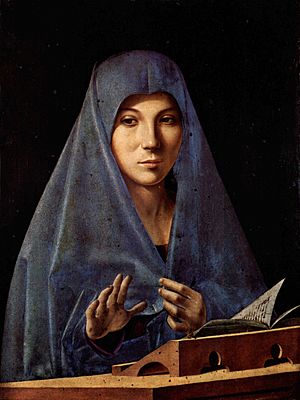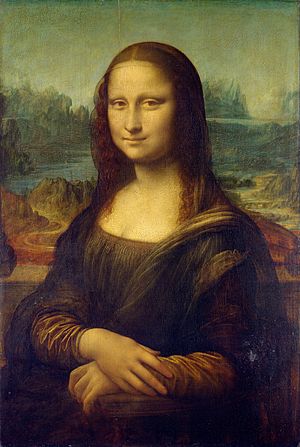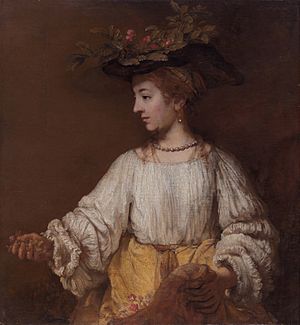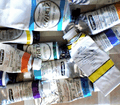Oil paint facts for kids
Oil paint is a classic way artists create paintings. In oil paint, tiny bits of pigments (which are the colors) are mixed with a special oil. The most common oil used for this is linseed oil.
A picture made with oil paint is called an "oil painting." One cool thing about oil paint is that it takes a long time to dry. This is super helpful for artists because they can work on their painting for many days or even weeks. For example, people say that Leonardo da Vinci worked on his famous Mona Lisa painting for four years! Even though it's not a huge picture, he kept adding details. Sometimes, oil paints and oil paintings are just called "oils" for short. So, if someone says they are "painting in oils," it means they are using oil paints.
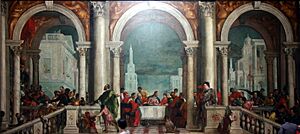
Contents
The History of Oil Painting
No one knows exactly when oil paint was first used. Some very old cave paintings in Afghanistan were made with paint mixed with oils. People think this type of paint was also used in other parts of Asia a long time ago.
In Europe, oil paint was probably first used in the Middle Ages. It was used to decorate things like shields. Oil paint was better than the older tempera paint because it lasted longer in bad weather and didn't get damaged easily.
A famous art historian named Giorgio Vasari once said that oil painting started in northern Europe. He thought the famous Flemish painter Jan van Eyck invented it. Artists from places like modern-day Belgium and the Netherlands were the first to regularly use oil painting. This new way of painting then spread to other parts of Northern Europe.
A very important painting called the Portinari Altarpiece by Hugo van der Goes arrived in Florence in the 1470s. This was when Leonardo da Vinci was still young. At that time, oil paintings were usually done on wooden panels, just like tempera paintings.
Another artist who helped spread oil painting in Italy was Antonello da Messina from Sicily. He learned how to paint with oils and traveled all over Italy, from Sicily to Venice. He made many small paintings, including portraits and pictures of the Madonna and Child and Jesus. He had a big impact on many artists, especially in Venice. Giovanni Bellini, who came from a family of well-known painters, was one of the first Italian artists to create very large pictures using oil paint. Artists from other parts of Italy visited Venice, and soon the new oil painting method became popular everywhere.
By the 1540s, very few painters still used tempera. In Italy, many artists still painted large pictures on walls and ceilings using frescos. However, artists soon found that oil paint was flexible. This meant it could bend without cracking or falling off. This was different from tempera. Because of this, oil paint could be used on flexible surfaces like cloth. Once painting on canvas (a strong linen cloth) became common, artists could create huge pictures. If a painting was too big to fit through a door, the artist could just roll it up!
Since the 1500s, oil painting has been the favorite choice for artists who want their artwork to last a very long time. The gallery below shows paintings by some of the most famous artists who used oil paint. Many famous artists of the 20th century also painted in oils, like Picasso, Matisse, Mondrian, Chagall, Kandinsky, Malevich, Salvador Dali, Francis Bacon, Lucien Freud, and Jackson Pollock.
Newer Paint Types
For a long time, until about 1960, oil paints and water paints were the main materials artists used. But in recent years, acrylic paints and water-mixable oil paints have become more and more popular.
How Oil Paint is Made and Used
Linseed oil, the main oil for oil painting, comes from the flax plant. Flax has been an important plant for thousands of years because linen cloth is also made from it. So, the oil for painting and the cloth to paint on can both come from the same plant! To get different effects, artists sometimes mix linseed oil with other oils. These can include pine resin, frankincense, poppy seed oil, walnut oil, and more recently, safflower oil.
Artists use turpentine or mineral spirits to make the paint thinner. This helps them create quick-drying sketches that they can paint over later with more detail. After painting, artists clean their brushes with turpentine. Today, modern chemists have even made oil paints that can be mixed with water. This makes cleaning up much easier and less smelly!
Oil paint usually feels dry to the touch in about a day to two weeks. How fast it dries depends on how much oil and turpentine is in it. An oil painting is often varnished when it's finished. Varnish gives the painting a slight shine and protects it. A painting should dry for several months before it is varnished. It's interesting to know that an oil painting isn't completely dry until it's 60 to 80 years old! In the past, varnishing was a very important step. However, many modern artists choose not to varnish their paintings at all.
Linen canvas is the traditional surface for an oil painting. Cotton canvas can also be used, and it's usually cheaper. The canvas must be stretched tightly over a wooden frame called a "stretcher." It's held in place with small tacks or staples. Then, the canvas needs to be treated with a type of glue called "size." This glue is often made from boiled rabbit skins. Some artists prefer to paint on wooden boards instead of canvas.
Painting with Oils
Before an artist can paint on a board or canvas, they must prepare it with a "ground" or "undercoat" of plain white paint. Then, the artist can sketch their picture onto the surface. They might use charcoal or paint that is made thin and dries quickly with turpentine. Artists often use a brownish or bluish color for this first sketch. This helps them plan where the "tone" (light and dark areas) will be in the final painting. After this, the colors and details are added in layers.
The great thing about oil paint is that it can be used in many ways that other paints cannot.
- Oil paint can be applied very thin or very thick.
- It can be as smooth as glass, or it can be lumpy, bumpy, or streaky.
- Oil paint can be transparent, so you can see the layers underneath. Or, it can be very thick and opaque, covering everything below it.
- Artists can apply oil paint with brushes. They can also scrape it on with a knife, dab and smear it with their fingers, rub it on with a cloth, or even squeeze it directly from the tube onto the painting!
Because oil paint is so versatile, it's excellent for showing different textures in a painting.
The first European artists who used oils liked to make the surface of their paintings very smooth. By the mid-1500s, some artists like Tintoretto started painting in a much streakier way. Rembrandt, in the 1600s, used oil paint in all sorts of ways to get different effects. He used every technique mentioned in the list above. After Rembrandt, some artists continued to work smoothly, while others used many different ways to apply the paint. This variety in technique has continued right up to modern times.
Related Art Topics
Images for kids
-
View of Delft in oil paint, by Johannes Vermeer.
See also
 In Spanish: Pintura al aceite para niños
In Spanish: Pintura al aceite para niños


